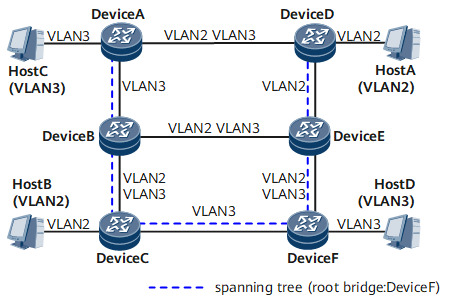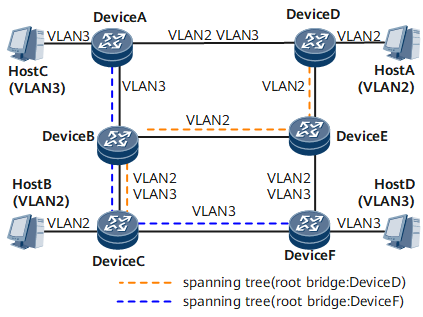MSTP Background
For RSTP and STP, all VLANs on a LAN use one spanning tree, and therefore VLAN-based load balancing cannot be performed. Once a link is blocked, it will no longer transmit traffic, wasting bandwidth and causing the failure in forwarding certain VLAN packets. MSTP overcomes the shortcoming of RSTP and STP and implements fast convergence and provides multiple paths to load balance VLAN traffic.
On the network shown in Figure 1, STP or RSTP is enabled. The broken line shows the spanning tree. Device F is the root device. The links between Device A and Device D and between Device B and Device E are blocked. VLAN packets are transmitted by using the corresponding links marked with "VLAN2" or "VLAN3."
Host A and Host B belong to VLAN 2 but they cannot communicate with each other because the link between Device B and Device E is blocked and the link between Device C and Device F denies packets from VLAN 2.
To overcome the defects of STP and RSTP, IEEE released 802.1S standard in 2002, which defined Multiple Spanning Tree Protocol (MSTP). MSTP is compatible with STP and RSTP and supports both fast convergence and multiple redundancy paths for data forwarding, achieving load balancing between VLAN data during data forwarding.
MSTP divides a switching network into multiple regions, each of which has multiple spanning trees that are independent of each other. Each spanning tree is called a Multiple Spanning Tree Instance (MSTI) and each region is called a Multiple Spanning Tree (MST) region.

An instance is a collection of VLANs. Binding multiple VLANs to an instance saves communication costs and reduces resource usage. The topology of each MSTI is calculated independent of one another, and traffic can be balanced among MSTIs. Multiple VLANs that have the same topology can be mapped to one instance. The forwarding status of the VLANs for a port is determined by the port status in the MSTI.
As shown in Figure 2, MSTP maps VLANs to MSTIs in the VLAN mapping table. Each VLAN can be mapped to only one MSTI. This means that traffic of a VLAN can be transmitted in only one MSTI. An MSTI, however, can correspond to multiple VLANs.
- MSTI 1 uses Device D as the root device to forward packets of VLAN 2.
- MSTI 2 uses Device F as the root device to forward packets of VLAN 3.
In this manner, devices within the same VLAN can communicate with each other; packets of different VLANs are load balanced along different paths.

